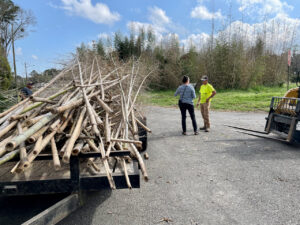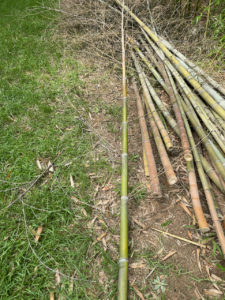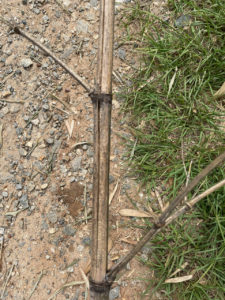Bamboo Fungus Disease
A common disease in parts of the Southeastern States kills bamboo.
 The historic Japanese timber grove at the Coastal Botanic Gardens in Savannah has died far back. Photo shows piles of dead grey poles and even more standing in place. The grove once was magnificent. It towered over visitors since at least the 1890s. A vivax grove shading a cow pasture east of Hawkinsville GA died back in the same way. Similar but less extensive dieback occurs each year at the Old Silverbrook Cemetary in Anderson, South Carolina.
The historic Japanese timber grove at the Coastal Botanic Gardens in Savannah has died far back. Photo shows piles of dead grey poles and even more standing in place. The grove once was magnificent. It towered over visitors since at least the 1890s. A vivax grove shading a cow pasture east of Hawkinsville GA died back in the same way. Similar but less extensive dieback occurs each year at the Old Silverbrook Cemetary in Anderson, South Carolina.
I have the disease at my bamboo farm in Hawkinsville GA. The disease clogs the vascular system of the plant so it can not carry enough water to the leaves. On a hot day, when the sun hits the upper leaves, the leaves curl up. Instead of uncurling during the night, they stay curled and die. The skin around them turns yellow. Branch by branch the death moves down the cane. Lower branches are green and healthy until the disease moves down. If I cut the cane quickly I can see the diseased part contrasting to the unaffected lower branches. If I don’t find the sick cane until death, the cane is grey like driftwood and often it has cracked open. Often the upper branches are blackened with spores.
The disease has infected moso, meyeri, tanake, bambusoides, vivax, praecox, and dulcis, but not henon, houzeau, shanghai #3, the nine dwarf bamboos or the five tropical bamboos. In 2021 a pathologist from the County Extension Service came to take a look. In 2023, I do not have results as to what the fungus is.
How to Combat the Disease.
Remove all dead and sick canes. We work with at least two people. One cuts; th other pulls the cut cane to the pile. The puller also “spots” the cane. Cutter shakes cane. “Is this the one?” Spotter/puller, “Yes, that is it”, or, “Go to your right and shake it”.
Kill the infected rhizome. The fungus resides in the rhizomes. Usually if an area has one dead cane, it has more. The rhizome in that area can only send up sick canes.
I have small tufts of bamboo here and there in the groves. Some of these tufts are green and healthy. Others are sick because they arise from an infected rhizome. They have yellow leaves with brown lines in some of the veins. To kill that rhizome, I spray RoundUp on these yellow tufts. “RoundUp is the only herbicide that kills the roots”, says Dr. Mark Czarnota PhD, University of Georgia Department of Georgia.
From 2021 to 2023, we spent hours cutting dying and dead poles from seven of my twelve groves. We chip the poles. Because of the virus in the poles, I do not spread the chips back into the groves. I use the chips on flower gardens; will sell some for mulch, and will make biochar from most of them.
Increase the health of the grove.
With plentiful organic amendments, this vigorous plant will outgrow the pathogen, I hope. I spread a lot of mulch. (The bamboo eats the mulch fast and there is never enough.) For a time, I spread llama poop from my neighbor. When I had steers, I spread cow manure and spoiled hay. The easiest to spread was hardwood sawdust. The hardest is my neighbor’s spoiled round bales of hay. I’d prefer to spread bamboo chips but can’t because they are infected with the disease.
I cycle the irrigation from grove to grove on a hot day, when we haven’t had rain, .
Twice, I have spread many pounds of powdered sulfur on the groves. Recently in desperation I bought bags of 10-10-10 fertilizer from a farm supply store and spread it on my moso.
Symptoms
When standing outside the grove and looking up, you see above the canopy some canes that have no leaves. The branches and canes look dark. When you go into the grove and cut the pole and pull it from the grove, you may see that the top branches and culm have lost all green. The leaves are dead and gone. The skin died and is grey. Below them, lower branches still have leaves and the skin of the branches and culm are still green. More advanced disease symptoms are that all leaves on all branches have died and the culm is discolored with streaking brown lines showing vascular death. The skin dies with streaks and blotches. By the time the disease has finished, all the moisture is pulled out. The cane is so dry that
canopy some canes that have no leaves. The branches and canes look dark. When you go into the grove and cut the pole and pull it from the grove, you may see that the top branches and culm have lost all green. The leaves are dead and gone. The skin died and is grey. Below them, lower branches still have leaves and the skin of the branches and culm are still green. More advanced disease symptoms are that all leaves on all branches have died and the culm is discolored with streaking brown lines showing vascular death. The skin dies with streaks and blotches. By the time the disease has finished, all the moisture is pulled out. The cane is so dry that  it rattles when you pull it out of the grove. It is grey. It has what looks like black soot at joints and even covering some of the internodes. Before long, the upper cane cracks open.
it rattles when you pull it out of the grove. It is grey. It has what looks like black soot at joints and even covering some of the internodes. Before long, the upper cane cracks open.